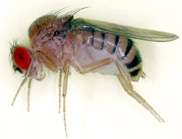E-Noses: Testing their mettle against fly noses

(PhysOrg.com) -- Scientists from CSIRO's Food Futures Flagship have made a breakthrough in efforts to extend the sensory range of 'electronic noses' (e-noses) by developing a system for comparing their performance against the much-superior nose of the common house fly.
"Although e-noses already have many uses - such as detecting spoilage in the food industry and monitoring air quality - they are not as discriminating as biological noses," according to CSIRO scientist, Dr Stephen Trowell.
"Our efforts to improve e-noses recently received a boost following our development of a new system which enables us to compare technical sensors with biological sensors.
"We looked at how the most common type of e-nose sensors - metal oxide or 'MOx' receptors - sample the air around them. This is a critical factor in the performance of all noses. We then compared it with the performance of odorant receptors from the common house fly, Drosophila.
"We already know that fly receptors, unlike most other bioreceptors, are not very specific. Even so, it really surprised us how much narrower the responses of the MOx sensors were than the biological ones. We also found that the fly bioreceptors outperformed the MOx sensors in their levels of independence. The fly seems to make a range of broadly tuned receptors that are independent of each other and human engineers haven't yet worked out how to do this.
"These results, published today in the science journal PLoS ONE, will help in the design of better e-noses and help us understand better how biological systems work," Dr Trowell said.
Bio-benchmarking approaches such as this could also be applied to other classes of electronic nose sensors. The CSIRO research team is looking to collaborate with developers of solid-state chemical sensors in the search for more effective devices.
This research is part of a much larger project developing an improved electronic nose, the Cybernose®, for use in the wine industry. Using insect receptors, the Cybernose will detect volatiles and contaminants in grapes and wine, thus allowing winemakers to improve their wines. When completed, the Cybernose will have wide application for detecting ripeness and spoilage in a range of foods as well as other applications such as detecting explosives.
The comparisons between the fly's receptors and those of the e-nose were made possible by recent descriptions of how odorant receptors function in Drosophila, which was the first insect to have its genome described. It was this new knowledge of the fly's genome that made the fly odorant receptor work possible.
More information: Amalia Z Berna, Alisha R Anderson, Stephen C Trowell. 2009. Bio-benchmarking of electronic nose sensors. PLoS ONE dx.plos.org/10.1371/journal.pone.0006406
Source: CSIRO Australia

















